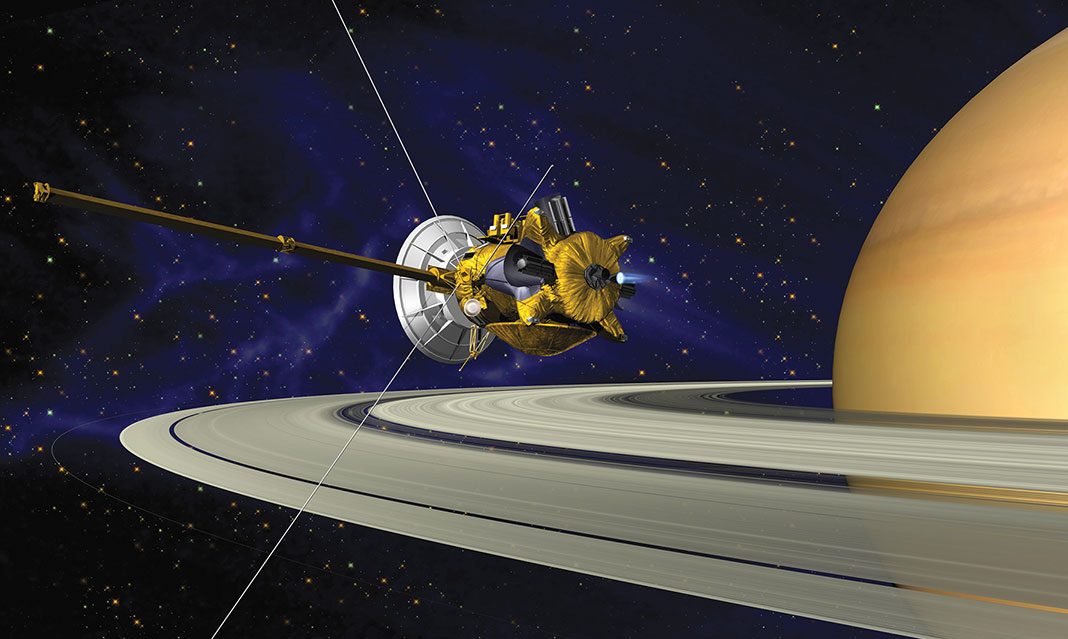Many of us won’t be able to recall where we were at the exact moment when Cassini-Huygens—commonly called Cassini—launched in 1997, reaching Saturn’s orbit in 2004. After remaining in orbit for more than 10 years, the Jet Propulsion Lab at the California Institute of Technology states how “Cassini has changed the course of planetary space exploration.”
Following 13 years of research on Saturn and it’s nearby moons, Cassini plunged to its death on September 15th in 2017. In what was referred to as “the grand finale,” Cassini dove into Saturn’s atmosphere because it was running out of fuel, sending atmospheric data back as long as its thrusters kept the antennae pointed towards Earth. They destroyed the robot intentionally to avoid crashing into and contaminating nearby moons that may hold potential to harbour life. The Jet Propulsion Lab at the California Institute of Technology stated in a mission briefing available on their website, “Operators are deliberately plunging Cassini into the planet to ensure Saturn’s moons will remain pristine for future exploration—in particular, the ice-covered, ocean-bearing moon Enceladus, but also Titan, with its intriguing pre-biotic chemistry.”
The mission briefing further describes how the mission cost $3.9 billion overall, $2.5 billion of which were contributions from the European Space Agency and the Italian Space Agency. Cassini has traveled 6.9 billion kilometres since its launch and, as described on NASA’s solar system exploration database, discovered six of Saturn’s 52 named moons. This 13-year mission, as CBC highlights in an article published on September 14, “Cassini turned planetary science on its head,” in the context of understanding Saturn’s and its moons’ ability to host life.
Professor Murray from the Science and Technology Facilities Council in the United Kingdom stated that Cassini-Huygens has allowed them to study Saturn in “unprecedented details and see it change before [their] eyes.” While Cassini spent 13 Earth years in orbit around Saturn, the equivalent is nearly half of a complete year in Saturn.
As described on NASA’s solar system exploration database, Cassini discovered water jets shooting from Saturn’s sixth largest moon, Enceladus’ south pole, at a speed of 400 metres per second. This discovery is particularly revolutionary because researchers had long believed the moons of giant gaseous planets to be inactive, according to the database. After receiving pictures from the Voyager missions in 1977, researchers had cause to delve further into the moons of these outer planets. Discovering the presence of water can be taken as an indicator of the moon being likely to host microbial life. Enceladus was initially thought to be too small to hold any potential thermal activity. However, in 2015, NASA announced that molecular hydrogen was found in hydrothermal vents which, as they describe, is largely what functions as an energy source for some microbes on Earth. By Cassini’s measurements, there is evidence to strongly suggest that there is an underground ocean on Enceladus.
The solar system exploration database goes on further to describe how similar evidence for conditions suitable for supporting life was also found on Titan, Saturn’s largest moon.
“This is the final chapter of an amazing mission, but it’s also a new beginning,” said Thomas Zurbuchen, associate administrator for NASA’s Science Mission Directorate at NASA Headquarters in Washington, at a press briefing. “Cassini’s discovery of ocean worlds at Titan and Enceladus changed everything, shaking our views to the core about surprising places to search for potential life beyond Earth.”
As stated in the mission briefing, after Cassini’s launch in 1997, it performed two Venus fly-bys, one Earth-Moon fly-by, followed by a course through the asteroid belt, and then performed one Jupiter fly-by all on its way to Saturn.
Cassini, the Jet Propulsion Lab explains, has allowed researchers to observe giant storms on the planet, with one on the northern hemisphere, referred to as “the dragon storm.” After a mission of recording the atmosphere moons and Saturn’s ring system in novel detail, in April 2017, Cassini was placed on an impact course that unfolded over five months of, what the Jet Propulsion Lab mission briefing describes as, “daring dives—a series of 22 orbits that each pass between the planet and its rings.”
As we look towards the future of space exploration, NASA is waiting for conclusions of investigations into other giant planets. The spacecraft, Juno, according to NASA’s Juno Mission Briefing, has been orbiting Jupiter since last summer. Two more Jupiter missions are to launch five years from now: NASA’s Europa Clipper spacecraft, which will study the possibly habitable Jovian moon Europa, and the European Space Agency’s Jupiter Icy Moons Explorer, which will investigate the giant planet and three of its four biggest moons, including Europa.
Although Earth has bid its goodbye to Cassini, Cassini project manager Earl Maize, of NASA’s Jet Propulsion Laboratory in Pasadena, California, describes during a news conference on September 13th, how this isn’t the end for Saturn either, “We left the world informed, but still wondering, and I couldn’t ask for more […] we’ve got to go back—we know it.”



